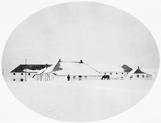2
Safely in Fort Edmonton for the winter, Jarvis and his men set about making friends with the inhabitants and scouting out the surrounding territory.Come spring they are given orders to build a new fort for themselves. The citizens of Edmonton make the mistake of demanding that Jarvis remain in their community. He therefore moves his men as far down the river as his orders allow, building a fort near the mouth of the Sturgeon River, and thus founding Fort Saskatchewan.
4
The group spent a comfortable winter at Fort Edmonton, having been given quarters inside the fort itself thanks to Chief Factor Richard Hardisty.At Christmas the police hosted a ball in the fort as thanks for the hospitality. The men voted to give a month's pay to pay the costs of the event.
The feast consisted of buffalo tongues, humps and hind quarters, as well as venison, prairie chicken and wild geese. Plum puddings and mince pies were also baked. The dinner and dance took place Christmas Eve and lasted until morning.
Christmas Day was spent at church, followed by another dinner and more dancing. The beverage of the day was tea, however, as liquor was forbidden. Inspector Jarvis and his men began patrolling the district, making a difficult trip to Buffalo Lake in weather as cold as 56 below zero.
6
In 1875, a committee put forth a proposal to Inspector Jarvis that detailed their willingness to pay the difference between the contract price of the timber at Fort Saskatchewan and that of Fort Edmonton, in order to secure the building of the Mounted Police Headquarters in Edmonton.Jarvis, a man of strong will, got angry and reactively built the headquarters 20 miles east on the South side of the North Saskatchewan River. So be it!
8
The Fort Saskatchewan arguement as documented by Sergeant-Major Samuel Steele:Orders arrived that winter: "Another mail came in during the winter with orders from the Commissioner for our commanding officer to prepare to build barracks for us on a site selected between the present fort and Sturgeon Creek, some 25 miles east. These instructions were soon known and a deputation of the people of the settlement came to Inspector Jarvis with blood in their eyes to interview him and demand that the barracks should be built at Edmonton. They did not use much tact, and they were trying to coerce the wrong man. Our O.C. was of a fiery temperament and would carry out his orders as he pleased, and was the last man to let himself be browbeaten. I have no doubt that if the settlers had let him alone he would have built the new post on the opposite side of the river. As it was, he chose a position 20 miles east, where he thought there would be a good railway crossing."
Steele went on to defend his commander, further, however, noting that the preliminary survey of the Canadian Pacific Survey passed well south of Edmonton at Hay Lakes, and it seemed likely the railroad would not pass through Edmonton. He also agreed with Jarvis that the new site would be much easier to bridge, having lower banks and easier access than the river crossing at Edmonton.
10
Jarvis therefore sent his men east to a point very near the Sturgeon Creek, where they began to build a fort in April, 1875."We made our own shingles, raised the walls, put on the roof, a new experience to many; but a few of us had been bred in the rural districts in the east, where every boy in those days was supposed to have an axe in his hands within a few weeks of his birth," wrote Steele.
The police built a men's building, officers' quarters, a guard-room and stables. Despite the hard construction work, life remained somewhat easier than it had been on the trail.
"Our food at this time consisted of pemmican and mountain trout," Steele wrote. "The smallest trout weighted five and a half pounds, and many were over twelve pounds. These fish have a flavour quite equal to salmon, but one does not so soon tire of them.
As an addition to our larder large quantities of wild duck eggs were obtained from the shores of the lakes in the Beaver Hills, to the south of our post, and an old Indian moose-hunter, who lived in the hills, brought us quantities of game in exchange for flour and tea. The favourite was beaver, which when roasted is delicious food."



